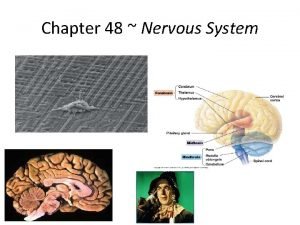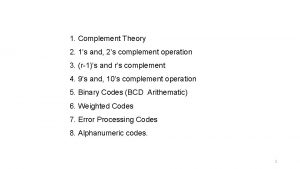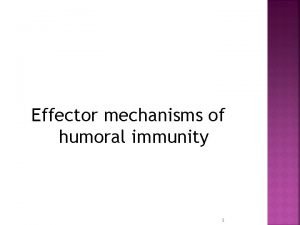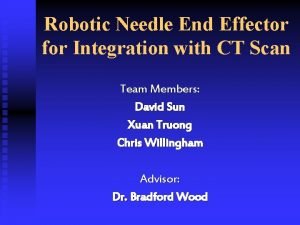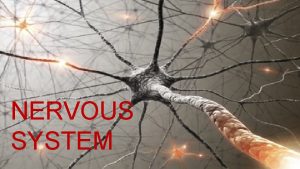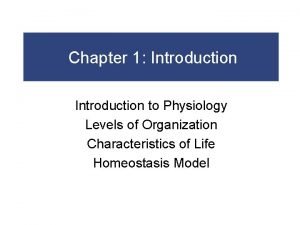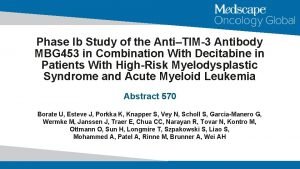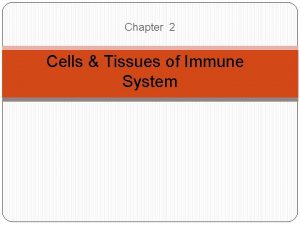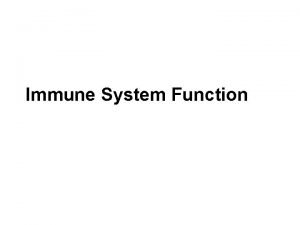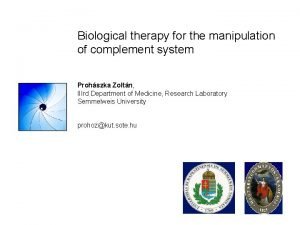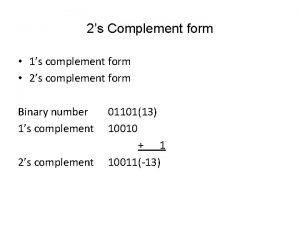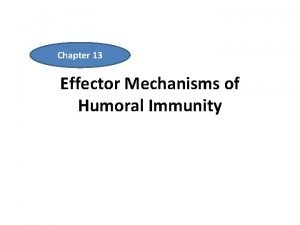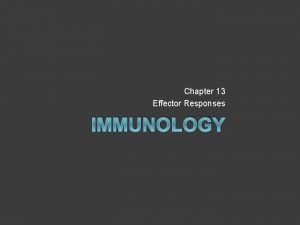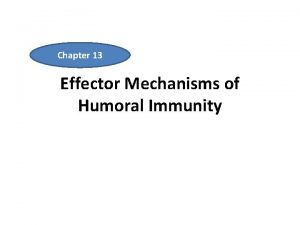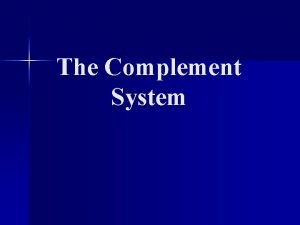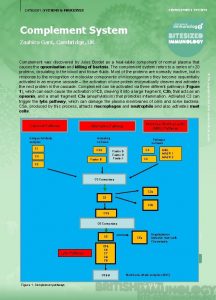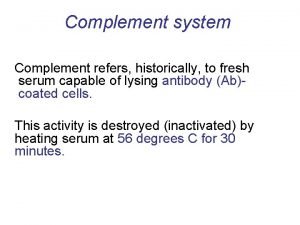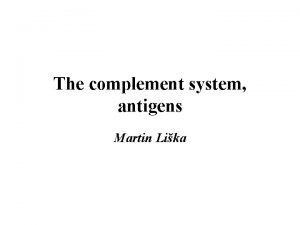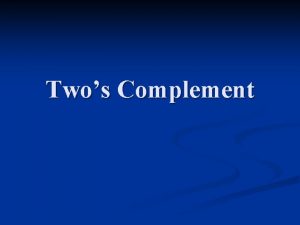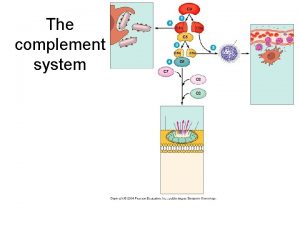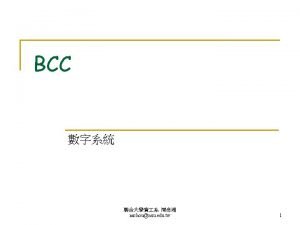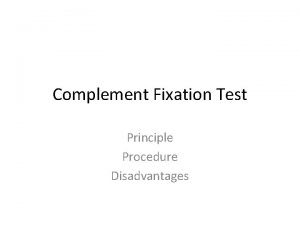Ch 7 The complement system Important effector in















































- Slides: 47

Ch. 7. The complement system Important effector in both innate and acquired immunity Over 30 circulating and membrane-bound proteins (synthesized in liver and other cells- immune and epithelial) Acts as a cascade (one event must occur before another takes place) Ch. 7

Cascade: Many of the components are enzymes that become activated when cleaved into two peptides One peptide binds to the immune complex and becomes a functional part of it The other peptide diffuses away and can become an inflammatory mediator (binds to a receptor) Ch. 7

Four important functions: Lysis Opsonization Activation of inflammatory response Clearance of immune complexes Ch. 7

p. 169 Ch. 7

Ch. 7

Ch. 7

Ch. 7

Ch. 7

Three pathways: classical, alternative, & lectin Final steps identical in all 3 pathways Classical - Initiated by formation of an Ag-Ab complex Alternative - Antibody-independent Part of innate immunity Initiated by foreign cell surfaces Lectin - Initiated by host proteins binding microbial surfaces Ch. 7

p. 170 Ch. 7

p. 171 Ch. 7

Ch. 7

Ch. 7

Ch. 7

Ch. 7

Ch. 7

Ch. 7

Classical pathway Classical was discovered first (but actually evolved later) Initiated by: -formation of a soluble Ag-Ab complex -binding of antibody to a target such as a bacterial cell Only certain antibodies can initiate this (Ig. M, some classes of Ig. G) Ch. 7

Ch. 7 p. 172

Ch. 7

Ch. 7

Ch. 7

Ch. 7

p. 175 Ch. 7

Alternative pathway Four components: C 3, factor B, factor D, properdin Triggering substances may be pathogens or nonpathogens (see p. 173, Table 7 -1): bacterial cell wall components, fungi, viruses, parasites immune complexes, RBCs, polymers Ch. 7

p. 173 Ch. 7

p. 174 Ch. 7

Lectin pathway Lectin is a protein that binds to carbohydrate MBL (mannose-binding lectin) binds to mannose on many bacterial cells MBL is produced by liver in acute-phase inflammatory reactions Once MBL binds to target cell, 2 serine proteases (MASP-1, MASP-2) bind Acts like C 1 Ch. 7

p. 176 Ch. 7

Regulation of complement system Because it is nonspecific, several regulatory mechanisms are involved (otherwise there would be a lot of “collateral damage”) Many components are very labile Many regulatory proteins block activity through binding to target (p. 177) Ch. 7

p. 178 Ch. 7

p. 178 Ch. 7

Ch. 7

Ch. 7

Biological effects of complement activation Complement fragments must bind to complement receptors expressed by various cells Ch. 7

p. 180 Ch. 7

p. 181 Ch. 7

Amplifies humoral response Destroys invading bacteria and viruses (lysis by MAC) Inflammatory response Opsonization of antigen (enhances phagocytosis) Virus neutralization Clearance of immune complexes Ch. 7

Some bacteria can resist lysis Gram-positive bacteria Some microbes produce inactivating enzymes Nucleated cells are harder to lyse Not particularly effective against tumor cells (they can endocytose MAC and repair damage) Ch. 7

Ch. 7 p. 182

Inflammation many of the released fragments help develop an inflammatory response C 3 a, C 4 a, C 5 a- anaphylotoxins bind to receptors on mast cells and basophils; degranulation (smooth muscle contraction; capillary dilation; fluid influx) also play a role in blood cell chemotaxis Ch. 7

Ch. 7 p. 184

Viral neutralization Some viruses activate alternative or lectin pathway Antibody-mediated (classical) pathway is more common Causes aggregation of viruses; can’t infect host cells; more vulnerable to phagocytes Enveloped viruses can be lysed Ch. 7

p. 186 Ch. 7

Consequences of complement deficiency Early components of classical pathway (C 1, C 4, C 2)- immune complex disease can’t generate C 3 b, which is needed for solubilization Recurrent Staph and Strep infections (can’t lyse bacteria but seem to control infections) Early components of alternative pathwaynot as serious; tendency to infections by Neisseria Ch. 7

C 3 deficiencies (can’t activate C 5 and form MAC) Recurrent severe bacterial infections MAC deficiencies- recurrent Neisseria infections no immune complex disease Regulatory protein deficiencies edema RBC lysis Ch. 7

Summary The complement system comprises a group of serum proteins which, when activated, plays an important role in antigen clearance. The classical, alternative and lectin pathways have been described. Elaborate regulatory mechanisms are required to prevent damage to normal cells. Ch. 7
 Effector cells nervous system
Effector cells nervous system Venn diagram terms
Venn diagram terms Bcd subtraction using 1's complement
Bcd subtraction using 1's complement Effector mechanism of humoral immunity
Effector mechanism of humoral immunity End effector needle
End effector needle Effector organ
Effector organ Stimulus in body temperature
Stimulus in body temperature Mbg 453
Mbg 453 Immune effector cells
Immune effector cells Antibody functions
Antibody functions Stimulus-sensor-coordinator-effector-response
Stimulus-sensor-coordinator-effector-response Homogeneous transformation matrix
Homogeneous transformation matrix Newspaper article format
Newspaper article format From most important to least important in writing
From most important to least important in writing Least important to most important
Least important to most important Opsonization
Opsonization Complement system
Complement system Hình ảnh bộ gõ cơ thể búng tay
Hình ảnh bộ gõ cơ thể búng tay Slidetodoc
Slidetodoc Bổ thể
Bổ thể Tỉ lệ cơ thể trẻ em
Tỉ lệ cơ thể trẻ em Gấu đi như thế nào
Gấu đi như thế nào Chụp tư thế worms-breton
Chụp tư thế worms-breton Bài hát chúa yêu trần thế alleluia
Bài hát chúa yêu trần thế alleluia Các môn thể thao bắt đầu bằng tiếng nhảy
Các môn thể thao bắt đầu bằng tiếng nhảy Thế nào là hệ số cao nhất
Thế nào là hệ số cao nhất Các châu lục và đại dương trên thế giới
Các châu lục và đại dương trên thế giới Công thức tính độ biến thiên đông lượng
Công thức tính độ biến thiên đông lượng Trời xanh đây là của chúng ta thể thơ
Trời xanh đây là của chúng ta thể thơ Mật thư tọa độ 5x5
Mật thư tọa độ 5x5 Làm thế nào để 102-1=99
Làm thế nào để 102-1=99 Phản ứng thế ankan
Phản ứng thế ankan Các châu lục và đại dương trên thế giới
Các châu lục và đại dương trên thế giới Thơ thất ngôn tứ tuyệt đường luật
Thơ thất ngôn tứ tuyệt đường luật Quá trình desamine hóa có thể tạo ra
Quá trình desamine hóa có thể tạo ra Một số thể thơ truyền thống
Một số thể thơ truyền thống Cái miệng nó xinh thế
Cái miệng nó xinh thế Vẽ hình chiếu vuông góc của vật thể sau
Vẽ hình chiếu vuông góc của vật thể sau Thế nào là sự mỏi cơ
Thế nào là sự mỏi cơ đặc điểm cơ thể của người tối cổ
đặc điểm cơ thể của người tối cổ V. c c
V. c c Vẽ hình chiếu đứng bằng cạnh của vật thể
Vẽ hình chiếu đứng bằng cạnh của vật thể Tia chieu sa te
Tia chieu sa te Thẻ vin
Thẻ vin đại từ thay thế
đại từ thay thế điện thế nghỉ
điện thế nghỉ Tư thế ngồi viết
Tư thế ngồi viết Diễn thế sinh thái là
Diễn thế sinh thái là
